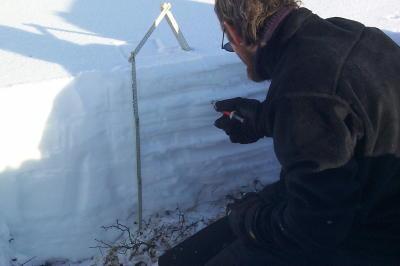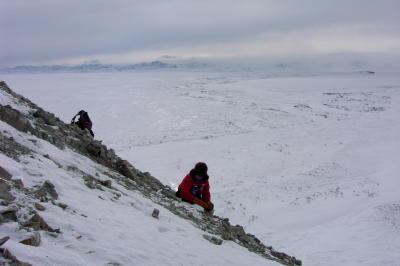13 April, 2002
Shovel in hand, the hard slab of snow is cut and then dug.
Dig, dig, dig and then dig some more. Dig until there is no
more snow showing, just the ground. Plop, sit down at the
bottom of the pit with whisk broom and measuring ruler in
hand and study the snow.
A snow pit has just been dug and will soon be analyzed.
Matthew has probably dug and analyzed more snow pits than
any other person in the world. He definitely has dug more
than any of us on this traverse. At the beginning of every
100-meter line, one primary snow pit is dug and
meticulously analyzed. Also along the 100-meter line, quick
snow pits are dug. A pit is dug at 25, 50, 75, and 100
meters. One person, who has often been me, digs all of the
quick pits. This is a sure way to warm up the body
especially when there is 50 cm of snow on the ground and
the air temperatures are well below freezing.
Matthew carries a black box that resembles a medical
doctor's box. Inside of this box is all of his equipment
to study the snow and analyze the snow pits. In this area
of the Arctic, all of the snow that has fallen since about
September remains on the ground. The snow may have changed
form and structure depending on the temperature, humidity
and wind. The snow ends up layering on top of one another
forming the snowpack. The snowpack can be read like a
book, sending messages about the weather for the year.
Matthew reads each of these layers, deciphering the
climate-related clues (such as temperature, wind, and
precipitation histories) they hold.
WHERE IS MRS. CHEUVRONT???? LET'S PLOT!!!
Latitude: 68.48202 degrees North
Longitude: 155.75247 degrees West
Ivotuk - our safe cabin on the prairie. It sets alone,
isolated on the plains of the Arctic. South of the cabin
is the beginning of the Brooks Range Mountains. The
mountains tower with their white, sharp, jagged peaks. The
cabin provided needed safety during the ground blizzard
yesterday. Today the storm has passed but clouds filtered
the sky.
The morning started with a retreat to an eroded hillside
that has exposed sedimentary rocks. Hidden within the rocks
are marine fossils dating back millions of years. The
fossils are mainly brachiopod fossils, small shelled
organisms. These animals are evidence that these rocks were
once deposited in a marine, ocean environment. These
fossils are tangible evidence that climate change has
occurred over millions of years. Sitting on the cliffside,
staring out across the horizon at the snow-covered
mountains peaks with the wind stinging my face; it was hard
to imagine that this area was once a warm, ocean
environment. The Earth is full of changes.
A complete snow-measurement site was finished in the
afternoon, along with multiple GPS/MagnaProbe lines. The
afternoon ended with a return to the small cabin. Another
storm had come upon us bringing snow and blowing winds.
The cabin welcomed us in from the cold with the promise of
a warm meal and a warm bed. It was good and comforting to
have the Ivotuk cabin as home instead of an exposed tent.
Temperature max: -7 degrees Celsius
Temperature min: -4 degrees Celsius
Matthew Sturm
USA-CRREL-Alaska
P.O. Box 35170
Ft. Wainwright, AK 99703
907-353-5183
msturm@crrel.usace.army.mil

Matthew in a snow pit making measurements. Notice the white measuring ruler.

Searching for brachiopod fossils on an eroded cliffside! It was also very windy on this cliff.
Contact the TEA in the field at
.
If you cannot connect through your browser, copy the
TEA's e-mail address in the "To:" line of
your favorite e-mail package.
|
